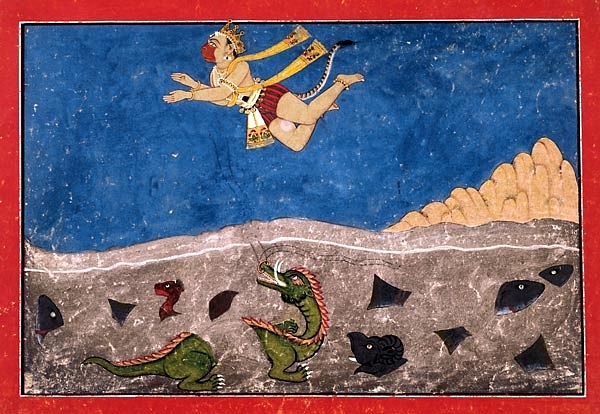
Book Review: Everything You Wanted To Know About The Hanuman Cālīsā
What explains the strange lack of traditional commentaries (ṭīka) of a text as popular as the Hanumān Cālīsā?
The Hanumān Cālīsā of Goswāmi Tulsidās enjoys a popularity unmatched by any other short religious text in India. The Gīta may command greater respect, but it is finally the Cālīsā that inhabits the tongues of millions of Hindus. One would be quite hard-pressed to find four walls in the north that have not heard the syllables of its Caupāis. The text is popular in the south too— schools (like my own) even recite it as a daily prayer. As Nityānanda Miśra puts it:
Quite like the majestic Hanuman who leaped across vast expanses of ocean and land, the Hanuman-Cālīsā transcends across diverse educational, social, linguistic, musical and geographic boundaries.
Ritual reciters swear upon the unmatched power of the Cālisā to confer material and spiritual rewards. How well it “works” is demonstrated by how the Cālīsā form has since been coopted by so many other (presumably envious) deities. There are now Kṛṣṇa, Śiva, Durga and Ganeśa Cālisās, to name a few (It works well to propitiate political deities too— there is even a Samajwādī Cālisā on Mulayam Singh Yadav).
As the folklore goes, Tulsidās composed the Cālisā while imprisoned by Akbar in Fathepur Sikri. He is said to have chanted the cālisā for 40 days, at the end of which an army of moneys ravaged the city, forcing the emperor to seek Tulsidās’ forgiveness. However, many scholars have adduced evidence that suggests that the Cālisā is a more recent work. For instance, the earliest manuscript of the Cālīsā does not appear till the mid-eighteenth century, while we have Rāmacaritmānas available from the 16th century.
This also explains the strange lack of traditional commentaries (ṭīka) of a text as popular as the Hanumān Cālīsā. Commentaries help contextualise the text and provide many deep insights. For this reason, they are ubiquitous in the Indian literary tradition. However, the Hanumān Cālīsā had to wait till 1984, to get its first proper commentary, when Jagadguru Rāmabhadrācārya’s Mahāvīrī was published.
Jagadguru Rāmabhadrācārya is one of the most remarkable figures of contemporary Hinduism. Blind since the age of two months, this author of over 100 books and four mahākāvyas speaks 22 languages fluently. By the age of seven, he had committed the entire Rāmacaritamānas (10,000 verses!) to memory. He does not read or write in Braille. Sound is his only medium of communication. He is widely regarded as one of the foremost authorities on Tulsidas. There is also much to be said about his social work, the expanse of which this piece is too small to contain. Nityānanda Miśra has now enabled Ramabhadracharya’s commentary on the Hanuman Cālīsā to reach a wider audience through his book Mahāvīrī: Hanuman Cālīsā Demystified, which translates it into English and expands upon it.
The bulk of the book is dominated by the English translation of Rāmabhadrācārya’s commentary. Beautifully typeset in LaTeX, the book is a delight to read. Compounds are neatly split, the meaning of every word is included, and a Sanskrit gloss is sometimes provided. The critical explanation (vyākhyā) that follows, draws upon a wide variety of texts— Upaniṣads, Bhagavadgītā, Rāmāyaṇa, Purāṇas et cetera— and offers many esoteric insights into the text. Interesting incidents and stories from a variety of sources are also interspersed throughout the commentary. The translation follows a more or less literal approach.
While many prefer this approach to religious texts (arguing that paraphrasing distorts the meaning), there is no denying that it makes for jarring reading. Elegance in Sanskritised Hindi has the tendency to turn into turgidity in English. For instance, the slick ityalamatipallavitena turns into “Enough of detailed amplification” and kāī biṣaya becomes the botanical sounding “The algae of sensual pleasures”. The upside is that the translation dovetails so tightly with the original that it is excellent help for someone reading Mahāvīrī’s Sanskritised Hindi side by side.
Nityānanda Miśra has significantly expanded upon the commentary. End notes are provided for the advanced reader, dealing with a range of topics from figures of speech to grammar. A half verse index and a word index is also included. For the musically inclined, musical notation has been provided for the traditional melody in the Miśra Khamāja rāga, complete with staff notation. There is even a section on prosody which discusses the metrical nuances of the Cālīsa in detail.
All in all, Mahāvīrī: Hanumān-Cālīsā Demystified is perhaps the most comprehensive guide to the Hanumān Cālīsā available in English. All those spiritually or academically interested in the Hanumān Cālīsa would find it a valuable read. There are a great many religious commentaries whose translations would benefit devotees, and I hope Nityānanda Miśra’s meticulously written book serves as a model for future efforts.